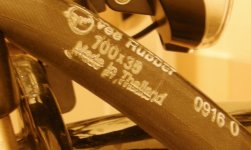=BicycleRider=
1 W
- Joined
- Jul 20, 2016
- Messages
- 61
I don't think so, it seems the downhill performance is reduced, it seems to have rolling resistance when the motor is off, I think.
Yep, there is always a compromise in puncture resistance improvement. Yet, riding lower pressure is a little compromise, as compared with adding slime and liner. You are adding some friction, but at least you are not adding to weight and moment of inertia. Then, the extra friction can be attenuated by using a tire design that has lower rolling resistance, and a wider rim that will give it good rolling properties with lower pressure.=BicycleRider= said:But I always thought with more pressure tyres rolled better and needed less energy to move.
Sure--it's just messy and time consuming.=BicycleRider= said:YThere's no way to take slime out once it's in is there?
Yep, that is what I think they've done. A bike shop did just that to a friend a few years ago. When he complained that his bike was hard to pedal they said: That is the qty that is sold, that is the qty that you've got. The bike ´tech' had figured out the bottle was for a pair of tires. Lucky it doesn't sell it by the gallon.amberwolf said:...But unless they used an entire bottle of slime in there I don't imagine the slime did that much to increase the rolling resistance.

